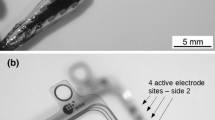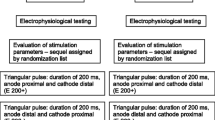Abstract
This study determined if high-frequency biphasic stimulation can induce nerve conduction block that persists after the stimulation is terminated, i.e., post-stimulation block. The frog sciatic nerve-muscle preparation was used in the study. Muscle contraction force induced by low-frequency (0.5 Hz) nerve stimulation was recorded to indicate the occurrence and recovery of nerve block induced by the high-frequency (5 or 10 kHz) biphasic stimulation. Nerve block was observed during high-frequency stimulation and after termination of the stimulation. The recovery from post-stimulation block occurred in two distinct phases. During the first phase, the complete block induced during high-frequency stimulation was maintained. The average maximal duration for the first phase was 107 ± 50 s. During the second phase, the block gradually or abruptly reversed. The duration of both first and second phases was dependent on stimulation intensity and duration but not frequency. Stimulation of higher intensity (1.4–2 times block threshold) and longer duration (5 min) produced the longest period (249 ± 58 s) for a complete recovery. Post-stimulation block can be induced by high-frequency biphasic stimulation, which is important for future investigations of the blocking mechanisms and for optimizing the stimulation parameters or protocols in clinical applications.





Similar content being viewed by others
References
Benabid AL, Pollak P, Gervason C, Hoffmann D, Gao DM, Hommel M, Perret JE, de Rougemont J (1991) Long-term suppression of tremor by chronic stimulation of the ventral intermediate thalamic nucleus. Lancet 337:403–406
Bhadra N, Kilgore KL (2005) High-frequency electrical conduction block of mammalian peripheral motor nerve. Muscle Nerve 32:782–790
Bhadra N, Kilgore KL (2014) Reversible nerve conduction block using kilohertz frequency alternating current. Neuromodulation 17:242–254
Bowman BR, McNeal DR (1986) Response of single alpha motoneurons to high-frequency pulse trains. Firing behavior and conduction block phenomenon. Appl Neurophysiol 49:121–138
Couto J, Grill WM (2016) Kilohertz frequency deep brain stimulation is ineffective at regularizing the firing of model thalamic neurons. Front Comput Neurosci 10:22
Cuellar JM, Alataris K, Walker A, Yeomans DC, Antognini JF (2013) Effect of high-frequency alternating current on spinal afferent nociceptive transmission. Neuromodulation 16:318–327
Frankenhaeuser B, Huxley AF (1964) The action potential in the myelinated nerve fibre of Xenopus laevis as computed on the basis of voltage clamp data. J Physiol 171:302–315
Gaunt RA, Prochazka A (2009) Transcutaneously coupled, high-frequency electrical stimulation of the pudendal nerve blocks external urethral sphincter contractions. Neurorehab Neural Repair 23:615–626
Hodgkin AL, Huxley AF (1952) A quantitative description of membrane current and its application to conduction and excitation in nerve. J Physiol 117:500–544
Joseph L, Butera R (2009) Unmyelinated aplysia nerves exhibit a nonmonotonic blocking response to high-frequency stimulation. IEEE Trans Neural Syst Rehabil Eng 17:537–544
Joseph L, Butera R (2011) High-frequency stimulation selectively blocks different types of fibers in frog sciatic nerve. IEEE Trans Neural Syst Rehabil Eng 19:550–557
Kilgore KL, Bhadra N (2004) Nerve conduction block utilising high-frequency alternating current. Med Biol Eng Comput 42:394–406
Liu H, Zhu L, Sheng S, Sun L, Zhou H, Tang H, Qiu T (2013) Post stimulus effects of high frequency biphasic electrical current on a fibre’s conductibility in isolated frog nerves. J Neural Eng 10:036024
Rattay F (1989) Analysis of models for extracellular fiber stimulation. IEEE Trans Biomed Eng 36:676–682
Rattay F, Aberham M (1993) Modeling axon membranes for functional electrical stimulation. IEEE Trans Biomed Eng 40:1201–1209
Reboul J, Rosenblueth A (1939) The action of alternating currents upon the electrical excitability of nerve. Am J Physiol 125:205–215
Rosenblueth A, Reboul J (1939) The blocking and deblocking effects of alternating currents on nerve. Am J Physiol 125:251–264
Sarr MG, Billington CJ, Brancatisano R, Brancatisano A, Toouli J, Kow L, Nguyen NT, Blackstone R, Maher JW, Shikora S, Reeds DN, Eagon JC, Wolfe BM, O’Rourke RW, Fujioka K, Takata M, Swain JM, Morton JM, Ikramuddin S, Schweitzer M, Chand B, Rosenthal R (2012) The EMPOWER study: randomized, prospective, double-blind, multicenter trial of vagal blockade to induce weight loss in morbid obesity. Obes Surg 22:1771–1782
Soin A, Shah NS, Fang ZP (2015) High-frequency electrical nerve block for postamputation pain: a pilot study. Neuromodulation 18:197–206
Tai C, de Groat WC, Roppolo JR (2005) Simulation analysis of conduction block in unmyelinated axons induced by high-frequency biphasic electrical currents. IEEE Trans Biomed Eng 52:1323–1332
Tai C, Roppolo JR, de Groat WC (2004) Block of external urethral sphincter contraction by high frequency electrical stimulation of pudendal nerve. J Urol 172:2069–2072
Tanner JA (1962) Reversible blocking of nerve conduction by alternating current excitation. Nature 195:712–713
Waataja J, Tweden K, Honda C (2011) Effects of high-frequency alternating current on axonal conduction through the vagus nerve. J Neural Eng 8:056013
Zhang X, Roppolo JR, de Groat WC, Tai C (2006) Mechanism of nerve conduction block induced by high-frequency biphasic electrical currents. IEEE Trans Biomed Eng 53:2445–2454
Acknowledgments
This study is supported by NIH/NIDDK under Grants DK-068566.
Author information
Authors and Affiliations
Corresponding author
Rights and permissions
About this article
Cite this article
Yang, G., Xiao, Z., Wang, J. et al. Post-stimulation block of frog sciatic nerve by high-frequency (kHz) biphasic stimulation. Med Biol Eng Comput 55, 585–593 (2017). https://doi.org/10.1007/s11517-016-1539-0
Received:
Accepted:
Published:
Issue Date:
DOI: https://doi.org/10.1007/s11517-016-1539-0




